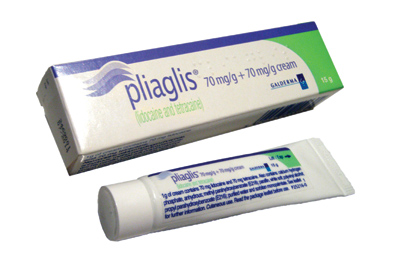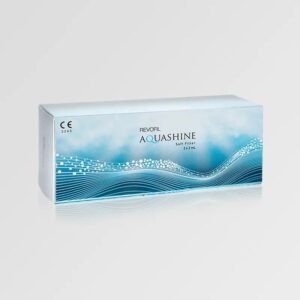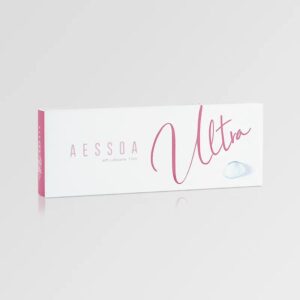Description
EXCIPIENTS
Anhydrous calcium hydrogen phosphate, purified water, polyvinyl alcohol, soft white paraffin , sorbitan monopalmitate, methyl parahydroxybenzoate (E218), propyl parahydroxybenzoate (E216).
INDICATIONS
This drug is indicated in adults to provide a local anaesthetic effect at the level of the dermis on intact skin before dermatological procedures.
CONTRAINDICATIONS/SIDE EFFECTS
Hypersensitivity to lidocaine, tetracaine, other ester or amid anaesthetics, para-aminobenzoic acid (a known derivative of tetracaine metabolism), methyl parahydroxybenzoate (E218), propyl parahydroxybenzoate (E216) or to any of the other excipients. This medicine should not be used on mucous membranes or on damaged or irritated skin.
DOSAGE
Dosage. Use in adults and the elderly: for dermatological procedures such as pulsed-dye laser therapy, laser-assisted hair removal, non-ablative laser facial resurfacing, dermal filler injections and vascular access, this medicine should be applied to intact skin at a thickness of approximately 1 mm for 30 minutes (approximately 1.3 g of cream per 10 cm^2). After the specified time, the tear-off mask should be removed from the skin before starting the procedure. For dermatological procedures such as laser-assisted tattoo removal and laser ablation of varicose veinson the legs, this medicine should be applied to intact skin at a thickness of approximately 1 mm for 60 minutes (approximately 1.3 g of cream per 10 cm^2). At the end of the specified time, the peel-off mask should be removed from the skin before starting the procedure. Surface area of the treatment site (cm²): 10. Approximate amount of this medicine dispensed (g): 1.3. 2 fingertip units. Surface area of the treatment site (cm²): 50. Approximate amount of this medicine dispensed (g): 6.5. Half the contents of a 15g tube. Surface area of the treatment site (cm²): 100. Approximate amount of this medicine dispensed (g): 13. The entire contents of a 15g tube. Treatment site surface area (cm²): 200. Approximate amount of this medicine dispensed (g): 26. The entire contents of one 30g tube. Treatment site surface area (cm²): 400. Approximate amount of this medicine dispensed (g): 52. The entire contents of two 30g tubes. The maximum surface area should not exceed 400 cm^2. Impaired hepatic, renal and cardiac function. This medicine should be used with caution in patients with impaired hepatic, renal and cardiac function. Paediatric population. The safety and efficacy of this medicine in children and adolescents aged up to 18 years have not yet been established. Therefore, the use of this medicine in children and adolescents is not currently recommended. Method of administration. This medicine is for single patient use only. For cutaneous use only. Precautions to be taken before handling or administering the medicine. For procedures on the face, this medicine should be applied by healthcare professionals. For procedures on all other parts of the body, this medicine should be applied by healthcare professionals or by patients themselves who have been properly trained in the appropriate application techniques. Patients and healthcare professionals are advised to avoid touching the cream or the skin covered with the cream in order to prevent contact dermatitis. This medicine should never be applied with the fingers. This medicine should only be applied using a flat-surfaced instrument such as a spatula or tongue depressor. Hands should be washed immediately after removal and disposal of the tear-off mask.
STORAGE
Store in the refrigerator (2 degrees C. – 8 degrees C.), even after opening. Do not freeze. Once opened, it should be used within 3 months. It is recommended to write the opening date of the product on the package.
WARNINGS
Avoid contact with eyes. Severe corneal damage has been observed in animal tests of similar products. This medicine should be used with caution near the eyes. If this medicine comes into contact with the eye, rinse immediately with water or sodium chloride solution and protect until sensation returns. Any residue from the peel-off mask of this medicine following removal should be carefully removed with a cotton swab. The treated area should not be occluded before removing this medicine from the skin. This medicine should not be applied for longer than specified. Rare allergic or anaphylactoid reactions may occur in association with lidocaine, tetracaine or other ingredients of this medicine. Tetracaine may be associated with these types of reactions more frequently than lidocaine. The use of several local anaesthetics, including tetracaine, has shown reactions of methaemoglobinaemia. The risk of methaemoglobinaemia is increased in patients with congenital or idiopathic methaemoglobinaemia. No cases of methaemoglobinaemia have been observed in clinical trials with this medicinal product. However, care should be taken to ensure that dosages, application areas and duration of application are consistent with those recommended for the population considered. Lidocaine has been shown to have an inhibitory action on viral and bacterial growth. The effect of lidocaine and tetracaine cream on intradermal injections of live vaccines has not been determined. Therefore, the use of the cream before the injection of live vaccines is not recommended. This medicinal product should be used with caution in patients with impaired hepatic, renal or cardiac function and in subjects with increased sensitivity to the effects of lidocaine and tetracaine on the systemic circulatory system, such as acute disease or in debilitated patients. Patients should be careful to avoid inadvertent trauma to the skin (through scratching, rubbing or exposure to extreme temperatures) while under the local anaesthetic effects of this medicine. This medicine contains methyl parahydroxybenzoate (E218) and propyl parahydroxybenzoate (E216) which may cause allergic reactions (possibly delayed).
INTERACTIONS
No interaction studies have been performed. The risk of additional systemic toxicity should be considered when this medicinal product is applied to patients receiving treatment with Class I antiarrhythmic medicinal products (such as quinidine, disopyramide, tocainide and mexiletine) and Class III antiarrhythmic medicinal products (e.g. amiodarone) or other products containing local anaesthetic agents. Interactions following appropriate use of this medicinal product are unlikely given the low concentration of lidocaine and tetracaine found in plasma after topical application of this medicinal product at the recommended doses. Patients taking medicinal products associated with drug-induced methemoglobinemia, such as fonamides, naphthalene, nitrates and nitrites, nitrofurantoin, nitroglycerin, nitroprusside, pamaquine and quinine have an increased risk of developing methemoglobinemia. Where this medicinal product is used concomitantly with other products containing lidocaine and/or tetracaine, the cumulative effect of the dosages of all formulations should be taken into account.
UNDESIRABLE EFFECTS
During clinical trials with this medicinal product, localized skin reactions at the application site were observed very commonly; however, these were moderate in severity and transient. The undesirable effects listed below include both treatment-related adverse events and erythema, skin oedema and skin discoloration assessed by skin reactivity rating scales. Application site adverse reactions occurring in more than 10% of patients were erythema and skin discoloration. Skin oedema was a common adverse reaction. All other adverse reactions occurred in less than 1% of patients. The adverse reactions, presented below, are classified by MedDRA System Organ Class and frequency, using the following convention: very common (>= 1/10), common (>= 1/100, < 1/10), uncommon (>= 1/1,000, < 1/100), rare (>= 1/10,000, < 1/1,000), very rare (<1>) .skin; uncommon: pruritus, skin pain; rare: pallor, skin burning sensation, facial swelling, skin peeling, skin irritation; not known: urticaria. General disorders and administration site conditions. Uncommon: pain. Rare allergic reactions or anaphylactoid reactions associated with lidocaine and tetracaine or other ingredients of this medicine may occur. Systemic adverse reactions following appropriate use of this medicine are unlikely because the dose of lidocaine and tetracaine absorbed is minimal. Reporting of suspected adverse reactions. Reporting suspected adverse reactions that occur after authorisation of the medicinal product is important, as it allows continued monitoring of the benefit/risk balance of the medicinal product. Healthcare professionals are asked to report any suspected adverse reactions via the national reporting system at .
PREGNANCY AND BREASTFEEDING
Pregnancy: There are no or limited amount of data on the use of this medicine in pregnant women. Animal studies do not show direct or indirect harmful effects of tetracaine with respect to reproductive toxicity. Animal studies are insufficient to demonstrate reproductive toxicity of lidocaine. Use with caution when used in pregnant women. Breastfeeding: lidocaine and tetracaine are excreted in breast milk, but at the recommended doses of this medicine, modest effects on breast-fed newborns or infants are expected. Therefore, this medicine can be used during breastfeeding provided that this medicine is not applied to the breast. Fertility: data on fertility relating to the use of lidocaine and tetracaine in humans do not exist. In animal studies, lidocaine and tetracaine have been shown not to alter fertility.
MONTREAL, March 10, 2020 /CNW Telbec/ – The topical analgesic Pliaglis has long been awaited by many doctors and dermatologists in Canada because it offers patients an effective alternative to traditional analgesic creams for relieving pain prior to superficial dermatological procedures. Effective, simple and easy-to-use because it can easily be removed after 20 minutes, Pliaglis delivers a unique concentration of topical anaesthetic agents to the market. In fact, it contains a higher concentration of lidocaine than other analgesic creams sold in Canada. It also contains tetracaine, a powerful analgesic commonly used in cosmetic procedures, such as laser therapy, intense pulsed light (IPL) therapy or electrolysis. When used at the recommended dosage, the product is safe, and it is the only formula with this maximum allowable concentration to be approved by Heath Canada. Now available by prescription in Canada, Pliaglis is the only topical analgesic approved by Health Canada and by the U.S. Food and Drug Administration (FDA).
Pliaglis delivers powerful pain-killing action and its unique application method – it is a peel-off cream1 which dries to form a pliable layer within 20 minutes – allows patients to benefit from optimum local anaesthesia for pain-free injections of collagen or dermal filler, hair removal, tattoo removal, laser therapy, resurfacing and other procedures.
Not only has the effectiveness and the high tolerance of Pliaglis been demonstrated in clinical trials2, but the product has been used successfully in medical practices in Europe, South America and the United States.
74% of patients considering a cosmetic procedure were concerned about pain3
Pliaglis is different from the other analgesic creams that patients are required to apply before a procedure. In addition to the recognized pain-killing action of lidocaine, the high concentration of tetracaine (7%) in Pliaglis gives patients and health professionals peace of mind about the efficacy of its numbing action, which lasts up to nine hours post-procedure.
The innovative application method improves the treatment experience
Pliaglis is applied by the health professional prior to the procedure using a spatula at a dosage of approximately 1.3g per square centimetre of skin. Thanks to “Peel” technology, the cream dries to form a pliable layer which acts like a medicinal patch. The lidocaine and tetracaine contained in Pliaglis are released to the pain receptors and nerve endings of the epidermis for optimal anaesthetic effect. The layer is peeled off after 30 minutes (in most cases) and the skin is then ready for the procedure.
Pliaglis has been certified safe by Health Canada and the product is sold only by prescription. Pliaglis is sold in a 30g tube at a recommended price of $50 (minimum of three tubes per order).
About Crescita Therapeutics Inc.
Crescita (TSX: CTX) is a publicly traded, Canadian commercial dermatology company with a manufacturing facility and a portfolio of non-prescription skincare products and prescription drugs for the treatment and care of skin conditions and diseases and their symptoms. Crescita owns multiple proprietary drug delivery platforms that support the development of patented formulations that can facilitate the delivery of active drugs into or through the skin.
|
_______________________________ |
|
|
1 |
Pliaglis monograph. CRESCITA Therapeutics Inc., December 4, 2012. Other topical anaesthetics currently on the market contain lidocaine and tetracaine in concentrations of 5%. |
|
2 |
Four clinical trials in which adults were treated either with Pliaglis or a placebo. |
|
3 |
Sarkany, M., Limitations of currently used topical anaesthetics in daily practice. Poster presented to the IMCAS World Congress 2012 as part of the 14th International Master Course on Ageing Skin, Paris, France, from January 26 to 29, 2012. |






Reviews
There are no reviews yet.